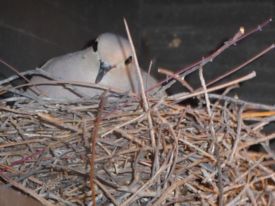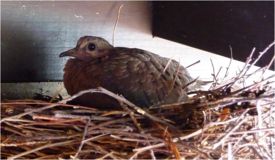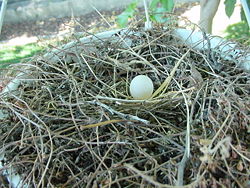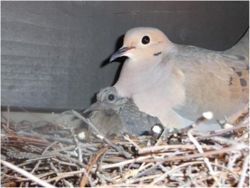Mourning dove: Difference between revisions
imported>Ro Thorpe mNo edit summary |
imported>John R. Brews (image) |
||
| (16 intermediate revisions by one other user not shown) | |||
| Line 1: | Line 1: | ||
{{subpages}} | {{subpages}} | ||
{{TOC|right}} | |||
{{Image|Mourning Dove.jpg|right|275px|Mourning dove}} | {{Image|Mourning Dove.jpg|right|275px|Mourning dove}} | ||
{{Image|Mourning dove nest.JPG|right|275px|Mourning dove on nest, Tucson, AZ}} | {{Image|Mourning dove nest.JPG|right|275px|Mourning dove on nest, Tucson, AZ}} | ||
The '''mourning dove''' (Zenaida macroura) is a common and widespread North American [[bird]] species in the family ''Columbidae''. It is widely found throughout the United States, parts of Canada, Mexico and Central America. Mourning doves are medium-sized birds pigmented in muted [[earth tone]]s. The soft cry of the mourning dove, from which it gets its name, is usually heard throughout the day. The mourning dove is monogamous and one of the few species of birds that | {{Image|Mourning dove squab.JPG|right|275px|Baby mourning dove}} | ||
The '''mourning dove''' (Zenaida macroura) is a common and widespread North American [[bird]] species in the family ''Columbidae''. It is widely found throughout the United States, parts of Canada, Mexico and Central America. Mourning doves are medium-sized birds pigmented in muted [[earth tone]]s. The soft cry of the mourning dove, from which it gets its name, is usually heard throughout the day. The mourning dove is monogamous and one of the few species of birds that pairs up to raise its young. | |||
== | == Appearance == | ||
The mourning dove is a ground feeder that eats seeds, insects and snails. A crop contains the seeds until the | The mourning dove is a ground feeder that eats seeds, insects and snails. A crop contains the seeds until the bird flies to higher ground to eat. Unlike humans, mourning doves can drink brackish water without dehydration.<ref name="urlMourning Dove, Life History, All About Birds - Cornell Lab of Ornithology">{{cite web | ||
|url=http://www.allaboutbirds.org/guide/Mourning_Dove/lifehistory | |url=http://www.allaboutbirds.org/guide/Mourning_Dove/lifehistory | ||
|title=Mourning Dove, Life History, All About Birds - Cornell Lab of Ornithology | |title=Mourning Dove, Life History, All About Birds - Cornell Lab of Ornithology | ||
| Line 11: | Line 13: | ||
|work= | |work= | ||
|accessdate=2010-08-10 | |accessdate=2010-08-10 | ||
}}</ref> | }}</ref><ref name="urlZenaida macroura">{{cite web | ||
<ref name="urlZenaida macroura">{{cite web | |||
|url=http://www.fs.fed.us/database/feis/animals/bird/zema/all.html | |url=http://www.fs.fed.us/database/feis/animals/bird/zema/all.html | ||
|title=Zenaida macroura | |title=Zenaida macroura | ||
| Line 18: | Line 19: | ||
|work= | |work= | ||
|accessdate=2010-08-10 | |accessdate=2010-08-10 | ||
}}</ref> | }}</ref><ref name="urlDNR - Mourning Dove (Zenaida macroura)">{{cite web | ||
<ref name="urlDNR - Mourning Dove (Zenaida macroura)">{{cite web | |||
|url=http://www.michigan.gov/dnr/0,1607,7-153-10370_12145_12202-77390--,00.html | |url=http://www.michigan.gov/dnr/0,1607,7-153-10370_12145_12202-77390--,00.html | ||
|title=DNR - Mourning Dove (Zenaida macroura) | |title=DNR - Mourning Dove (Zenaida macroura) | ||
| Line 26: | Line 26: | ||
|accessdate=2010-08-10 | |accessdate=2010-08-10 | ||
}}</ref> | }}</ref> | ||
Currently, there are two subspecies of the mourning dove found in the United States. They are | Currently, there are two subspecies of the mourning dove found in the United States. They are carolinensis (Linnaeus), which occurs east of the Mississippi River, and marginella (Woodhouse), which occurs in the western two-thirds of the United States. The western mourning dove is slightly smaller and paler in color than the Eastern species of mourning dove. An intermediate form of the two species is found in a zone ranging from Michigan through eastern Texas.<ref name="urlZenaida macroura">{{cite web | ||
occurs in the western two-thirds of the United States. The western mourning dove is slightly smaller and paler in color than the Eastern species of mourning dove. An intermediate form of the two species is found in a zone ranging from Michigan through eastern Texas. | |||
<ref name="urlZenaida macroura">{{cite web | |||
|url=http://www.fs.fed.us/database/feis/animals/bird/zema/all.html | |url=http://www.fs.fed.us/database/feis/animals/bird/zema/all.html | ||
|title=Zenaida macroura | |title=Zenaida macroura | ||
| Line 37: | Line 35: | ||
Mourning doves are plumpish looking birds, with round bodies, and a small head. Their bill is small as well as their legs. They have an elongated tail that is pointed. | Mourning doves are plumpish looking birds, with round bodies, and a small head. Their bill is small as well as their legs. They have an elongated tail that is pointed. | ||
Coloration | ===Coloration=== | ||
<ref name="urlMourning Dove, Life History, All About Birds - Cornell Lab of Ornithology">{{cite web | The sexes of the mourning dove look similar. The back of the bird is grayish-brown color and the undersides are buff. There are black spots on the wings and behind the eye. White can be seen on the tail feathers when the mourning dove is in flight. Juvenile mourning doves have buff coloring on the tips of their primary feathers; this coloration disappears after their first molt.<ref name="urlMourning Dove, Life History, All About Birds - Cornell Lab of Ornithology">{{cite web | ||
|url=http://www.allaboutbirds.org/guide/Mourning_Dove/lifehistory | |url=http://www.allaboutbirds.org/guide/Mourning_Dove/lifehistory | ||
|title=Mourning Dove, Life History, All About Birds - Cornell Lab of Ornithology | |title=Mourning Dove, Life History, All About Birds - Cornell Lab of Ornithology | ||
| Line 44: | Line 42: | ||
|work= | |work= | ||
|accessdate=2010-08-10 | |accessdate=2010-08-10 | ||
}}</ref> | }}</ref><ref name="urlDNR - Mourning Dove (Zenaida macroura)">{{cite web | ||
<ref name="urlDNR - Mourning Dove (Zenaida macroura)">{{cite web | |||
|url=http://www.michigan.gov/dnr/0,1607,7-153-10370_12145_12202-77390--,00.html#Identification | |url=http://www.michigan.gov/dnr/0,1607,7-153-10370_12145_12202-77390--,00.html#Identification | ||
|title=DNR - Mourning Dove (Zenaida macroura) | |title=DNR - Mourning Dove (Zenaida macroura) | ||
| Line 52: | Line 49: | ||
|accessdate=2010-08-10 | |accessdate=2010-08-10 | ||
}}</ref> | }}</ref> | ||
== | |||
== Dimensions == | |||
Males and females range from 9.1 to 13.4 inches (23 to 24 centimeters) in length. Wingspan is 17.4 inches or 45 centimeters for both sexes. | Males and females range from 9.1 to 13.4 inches (23 to 24 centimeters) in length. Wingspan is 17.4 inches or 45 centimeters for both sexes. | ||
Male: 9.1 to 13.4 inches or 23 to 24 centimeters length. Wingspan is 17.4 inches or 45 centimeters. Weight is 3.4 to 6 ounces or 96 to 170 grams. Females weigh slightly less than males. The weight range for the mourning dove is 3 to 6 ounces or 96 to 170 grams. | Male: 9.1 to 13.4 inches or 23 to 24 centimeters length. Wingspan is 17.4 inches or 45 centimeters. Weight is 3.4 to 6 ounces or 96 to 170 grams. Females weigh slightly less than males. The weight range for the mourning dove is 3 to 6 ounces or 96 to 170 grams.<ref name="urlMourning Dove, Life History, All About Birds - Cornell Lab of Ornithology">{{cite web | ||
<ref name="urlMourning Dove, Life History, All About Birds - Cornell Lab of Ornithology">{{cite web | |||
|url=http://www.allaboutbirds.org/guide/Mourning_Dove/lifehistory | |url=http://www.allaboutbirds.org/guide/Mourning_Dove/lifehistory | ||
|title=Mourning Dove, Life History, All About Birds - Cornell Lab of Ornithology | |title=Mourning Dove, Life History, All About Birds - Cornell Lab of Ornithology | ||
| Line 62: | Line 59: | ||
|work= | |work= | ||
|accessdate=2010-08-10 | |accessdate=2010-08-10 | ||
}}</ref> | }}</ref><ref name="urlMourning Dove">{{cite web | ||
<ref name="urlMourning Dove">{{cite web | |||
|url=http://www.wbu.com/chipperwoods/photos/mdove.htm | |url=http://www.wbu.com/chipperwoods/photos/mdove.htm | ||
|title=Mourning Dove | |title=Mourning Dove | ||
| Line 72: | Line 68: | ||
== Migration == | == Migration == | ||
Mourning doves residing in northern sections of the United States and Canada migrate to southern regions including Mexico. Southern mourning doves may migrate for short distances or winter over in their present habitat. | Mourning doves residing in northern sections of the United States and Canada migrate to southern regions including Mexico. Southern mourning doves may migrate for short distances or winter over in their present habitat.<ref name="urlMourning Dove, Life History, All About Birds - Cornell Lab of Ornithology">{{cite web | ||
<ref name="urlMourning Dove, Life History, All About Birds - Cornell Lab of Ornithology">{{cite web | |||
|url=http://www.allaboutbirds.org/guide/Mourning_Dove/lifehistory | |url=http://www.allaboutbirds.org/guide/Mourning_Dove/lifehistory | ||
|title=Mourning Dove, Life History, All About Birds - Cornell Lab of Ornithology | |title=Mourning Dove, Life History, All About Birds - Cornell Lab of Ornithology | ||
| Line 83: | Line 78: | ||
{{Image|Mourning Dove Egg.JPG|right|250px|Mourning dove eggs.}} | {{Image|Mourning Dove Egg.JPG|right|250px|Mourning dove eggs.}} | ||
{{Image|Dove with squab.JPG|right|250px|Mourning dove with squab.}} | {{Image|Dove with squab.JPG|right|250px|Mourning dove with squab.}} | ||
Mourning doves are monogamous and | Mourning doves are monogamous and some pairs stay together throughout the winter. Nesting takes place between mid-March and mid-September. Mourning doves go through a courtship ritual, bond, and a few days later start to build the nest. Nest building takes up to 10 hours to complete. After the nest is completed, the female normally lays a clutch of two white eggs. Approximately 15 days later the young birds hatch. The young mourning doves leave the nest about two weeks after they are hatched. | ||
Male mourning doves normally incubate the eggs during the day while the female incubates the eggs during the night. | Male mourning doves normally incubate the eggs during the day while the female incubates the eggs during the night. The birds take turns feeding the young doves, also called squabs, when the birds are in the nest. During the first three to four days the squabs are fed crop milk, an energy-rich substance that is produced in the crops of both male and female parents. Later both parents feed the bird regurgitated seeds.<ref name="urlADW: Zenaida macroura: Information">{{cite web | ||
|url=http://animaldiversity.ummz.umich.edu/site/accounts/information/Zenaida_macroura.html | |url=http://animaldiversity.ummz.umich.edu/site/accounts/information/Zenaida_macroura.html | ||
|title=ADW: Zenaida macroura: Information | |title=ADW: Zenaida macroura: Information | ||
| Line 91: | Line 86: | ||
|work= | |work= | ||
|accessdate=2010-08-10 | |accessdate=2010-08-10 | ||
}}</ref> | }}</ref><ref name="urlZenaida macroura">{{cite web | ||
<ref name="urlZenaida macroura">{{cite web | |||
|url=http://www.fs.fed.us/database/feis/animals/bird/zema/all.html | |url=http://www.fs.fed.us/database/feis/animals/bird/zema/all.html | ||
|title=Zenaida macroura | |title=Zenaida macroura | ||
| Line 98: | Line 92: | ||
|work= | |work= | ||
|accessdate=2010-08-10 | |accessdate=2010-08-10 | ||
}}</ref> | }}</ref><ref name="urlMourning Dove, Life History, All About Birds - Cornell Lab of Ornithology">{{cite web | ||
<ref name="urlMourning Dove, Life History, All About Birds - Cornell Lab of Ornithology">{{cite web | |||
|url=http://www.allaboutbirds.org/guide/Mourning_Dove/lifehistory | |url=http://www.allaboutbirds.org/guide/Mourning_Dove/lifehistory | ||
|title=Mourning Dove, Life History, All About Birds - Cornell Lab of Ornithology | |title=Mourning Dove, Life History, All About Birds - Cornell Lab of Ornithology | ||
| Line 110: | Line 103: | ||
<blockquote>Mourning dove predators include humans, hawks (Accipitridae), owls | <blockquote>Mourning dove predators include humans, hawks (Accipitridae), owls | ||
(Stringidae and Tytonidae), cats (Felidae), dogs (Canidae), blue jays | (Stringidae and Tytonidae), cats (Felidae), dogs (Canidae), blue jays | ||
(Cyanocitta cristata), and squirrels | (Cyanocitta cristata), and squirrels.<ref name="urlZenaida macroura">{{cite web | ||
<ref name="urlZenaida macroura">{{cite web | |||
|url=http://www.fs.fed.us/database/feis/animals/bird/zema/all.html | |url=http://www.fs.fed.us/database/feis/animals/bird/zema/all.html | ||
|title=Zenaida macroura | |title=Zenaida macroura | ||
| Line 118: | Line 110: | ||
|accessdate=2010-08-10 | |accessdate=2010-08-10 | ||
}}</ref> | }}</ref> | ||
</blockquote> | |||
== Mortality == | == Mortality == | ||
Mourning doves usually have a short life span and a high mortality rate. Approximately 6 out of 10 mourning doves will not survive from one year to the next. <ref name="urlDNR - Mourning Dove (Zenaida macroura)">{{cite web | Mourning doves usually have a short life span and a high mortality rate. Approximately 6 out of 10 mourning doves will not survive from one year to the next.<ref name="urlDNR - Mourning Dove (Zenaida macroura)">{{cite web | ||
|url=http://www.michigan.gov/dnr/0,1607,7-153-10370_12145_12202-77390--,00.html#Identification | |url=http://www.michigan.gov/dnr/0,1607,7-153-10370_12145_12202-77390--,00.html#Identification | ||
|title=DNR - Mourning Dove (Zenaida macroura) | |title=DNR - Mourning Dove (Zenaida macroura) | ||
| Line 135: | Line 129: | ||
== Population == | == Population == | ||
The mourning dove population is abundant; it is not considered a threatened species.<ref name="urlDNR - Mourning Dove (Zenaida macroura)">{{cite web | |||
|url=http://www.michigan.gov/dnr/0,1607,7-153-10370_12145_12202-77390--,00.html#Migration%20Patterns | |url=http://www.michigan.gov/dnr/0,1607,7-153-10370_12145_12202-77390--,00.html#Migration%20Patterns | ||
|title=DNR - Mourning Dove (Zenaida macroura) | |title=DNR - Mourning Dove (Zenaida macroura) | ||
| Line 144: | Line 138: | ||
== Habitat == | == Habitat == | ||
Mourning doves have adapted to almost all environments. They can be found in the countryside or in cities and suburbs | Mourning doves have adapted to almost all environments. They can be found in the countryside or in cities and suburbs, but they do avoid heavily forested areas.<ref name="urlZenaida macroura">{{cite web | ||
|url=http://www.fs.fed.us/database/feis/animals/bird/zema/all.html | |url=http://www.fs.fed.us/database/feis/animals/bird/zema/all.html | ||
|title=Zenaida macroura | |title=Zenaida macroura | ||
Latest revision as of 07:18, 3 April 2011
The mourning dove (Zenaida macroura) is a common and widespread North American bird species in the family Columbidae. It is widely found throughout the United States, parts of Canada, Mexico and Central America. Mourning doves are medium-sized birds pigmented in muted earth tones. The soft cry of the mourning dove, from which it gets its name, is usually heard throughout the day. The mourning dove is monogamous and one of the few species of birds that pairs up to raise its young.
Appearance
The mourning dove is a ground feeder that eats seeds, insects and snails. A crop contains the seeds until the bird flies to higher ground to eat. Unlike humans, mourning doves can drink brackish water without dehydration.[1][2][3] Currently, there are two subspecies of the mourning dove found in the United States. They are carolinensis (Linnaeus), which occurs east of the Mississippi River, and marginella (Woodhouse), which occurs in the western two-thirds of the United States. The western mourning dove is slightly smaller and paler in color than the Eastern species of mourning dove. An intermediate form of the two species is found in a zone ranging from Michigan through eastern Texas.[2] Mourning doves are plumpish looking birds, with round bodies, and a small head. Their bill is small as well as their legs. They have an elongated tail that is pointed.
Coloration
The sexes of the mourning dove look similar. The back of the bird is grayish-brown color and the undersides are buff. There are black spots on the wings and behind the eye. White can be seen on the tail feathers when the mourning dove is in flight. Juvenile mourning doves have buff coloring on the tips of their primary feathers; this coloration disappears after their first molt.[1][3]
Dimensions
Males and females range from 9.1 to 13.4 inches (23 to 24 centimeters) in length. Wingspan is 17.4 inches or 45 centimeters for both sexes.
Male: 9.1 to 13.4 inches or 23 to 24 centimeters length. Wingspan is 17.4 inches or 45 centimeters. Weight is 3.4 to 6 ounces or 96 to 170 grams. Females weigh slightly less than males. The weight range for the mourning dove is 3 to 6 ounces or 96 to 170 grams.[1][4]
Migration
Mourning doves residing in northern sections of the United States and Canada migrate to southern regions including Mexico. Southern mourning doves may migrate for short distances or winter over in their present habitat.[1]
Reproduction
Mourning doves are monogamous and some pairs stay together throughout the winter. Nesting takes place between mid-March and mid-September. Mourning doves go through a courtship ritual, bond, and a few days later start to build the nest. Nest building takes up to 10 hours to complete. After the nest is completed, the female normally lays a clutch of two white eggs. Approximately 15 days later the young birds hatch. The young mourning doves leave the nest about two weeks after they are hatched.
Male mourning doves normally incubate the eggs during the day while the female incubates the eggs during the night. The birds take turns feeding the young doves, also called squabs, when the birds are in the nest. During the first three to four days the squabs are fed crop milk, an energy-rich substance that is produced in the crops of both male and female parents. Later both parents feed the bird regurgitated seeds.[5][2][1]
Predators
Mourning dove predators include humans, hawks (Accipitridae), owls
(Stringidae and Tytonidae), cats (Felidae), dogs (Canidae), blue jays (Cyanocitta cristata), and squirrels.[2]
Mortality
Mourning doves usually have a short life span and a high mortality rate. Approximately 6 out of 10 mourning doves will not survive from one year to the next.[3] Other sources report an average lifespan of 1.5 years. The oldest recorded age for a wild mourning dove was 19.3 years old.[5]
Population
The mourning dove population is abundant; it is not considered a threatened species.[3]
Habitat
Mourning doves have adapted to almost all environments. They can be found in the countryside or in cities and suburbs, but they do avoid heavily forested areas.[2]
References
- ↑ 1.0 1.1 1.2 1.3 1.4 Mourning Dove, Life History, All About Birds - Cornell Lab of Ornithology. Retrieved on 2010-08-10.
- ↑ 2.0 2.1 2.2 2.3 2.4 Zenaida macroura. Retrieved on 2010-08-10.
- ↑ 3.0 3.1 3.2 3.3 DNR - Mourning Dove (Zenaida macroura). Retrieved on 2010-08-10. Cite error: Invalid
<ref>tag; name "urlDNR - Mourning Dove (Zenaida macroura)" defined multiple times with different content Cite error: Invalid<ref>tag; name "urlDNR - Mourning Dove (Zenaida macroura)" defined multiple times with different content Cite error: Invalid<ref>tag; name "urlDNR - Mourning Dove (Zenaida macroura)" defined multiple times with different content - ↑ Mourning Dove. Retrieved on 2010-08-10.
- ↑ 5.0 5.1 ADW: Zenaida macroura: Information. Retrieved on 2010-08-10.




